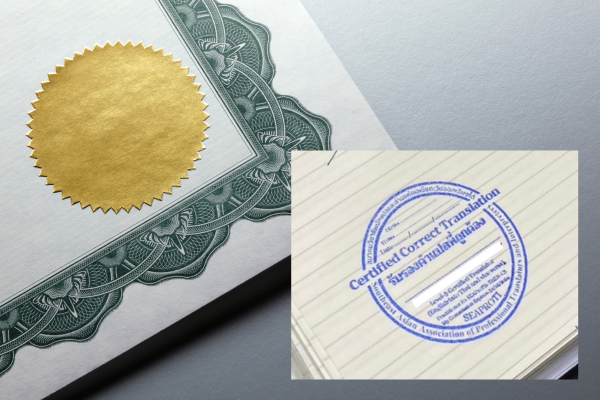
Understanding Certified Translations vs. Notarized Translations
Certified translations are extremely important in the translation industry. Nevertheless, what really is a certified translation? We shall examine the fundamentals of certified translations, typical applications, and certification requirements in this post.
What is a Certified Translation?
Anyone in Thailand is able to certify translations. An individual translator or an employee of a translation agency can both get certified. The translation's accuracy and completeness must be met during certification, and this is a crucial requirement. Translations made by their own staff members or independent contractors are frequently certified by translation agencies. To certify a translation for oneself or a member of one's family is generally discouraged, though, as it runs the risk of being rejected by the intended audience.
What is Included in the Certification Statement?
A certification statement should include the following information:
- Identification of the language and the translated document
- A description of the qualifications of the translator
- Confirmation of the document's accuracy and completeness
- Name, date, and signature of the translator
Both short and extended sample certification statements are offered by members of the Southeast Asian Association of Professional Translators and Interpreters (SEAPrOTI). Consult one of our specialists here: https://www.seaproti.org/Practitioners
What is the Difference Between a Certified Translation and a Notarized Translation?
Some customers could ask for or need a "notarized translation." This nomenclature is incorrect, though. A notary public just confirms the signer's identification on the certification statement. The translation cannot be notarized in and of itself. The certification statement must only be signed in front of a notary because they must attest to the translator's signature, it is very crucial to remember this.
Common Uses of Certified Translations
Certified translations are often required for various purposes:
- Legal proceedings (civil and criminal)
- Procedures with government entities (e.g., visa applications, driver's license, public benefits)
- Educational institutions (application documents)
For instance, certified translations are required when requesting public assistance or applying for a visa. Similar requirements apply when submitting application materials to educational institutions or during judicial processes.
The SEAProTI-Certified Translator Seal
Only translators who have received SEAProTI accreditation are eligible to use the certification seal. Clients and companies may quickly identify the credentials of qualified translators thanks to this seal. It can be included in the certification of accuracy statements, business cards, and resumes. The mark contains information on how to check the translator's status as a certified translator online. Some governmental organizations will accept certified translations without a notarization if they bear the SEAProTI-certified translator seal.
Conclusion
In numerous legal, governmental, and educational contexts, certified translations are essential. Both translators and end users must be familiar with the fundamentals of certified translations, such as the certification procedure and typical applications. Translation professionals may deliver accurate and trustworthy translations while assuring compliance with the needs of the end user by adhering to the criteria and rules for certification.
"เอกสารแปลเอกสารรับรอง" (Certified Translation) มีความสำคัญอย่างยิ่งในอุตสาหกรรมการแปล แต่การแปลที่ได้รับการรับรองคืออะไร ในบทความนี้ เราจะมาดูพื้นฐานของการแปลที่ได้รับการรับรอง การใช้งานทั่วไป และข้อกำหนดในการรับรอง
การแปลเอกสารรับรองคืออะไร
ทุกคนในประเทศไทยสามารถรับรองการแปลได้ บุคคลหรือพนักงานของหน่วยงานแปลก็ได้เช่นกัน สิ่งสำคัญคือต้องปฏิบัติตามข้อกำหนดความถูกต้องและความสมบูรณ์ของคำแปลในระหว่างการรับรอง หน่วยงานแปลมักให้การรับรองการแปลที่จัดทำโดยพนักงานของตนเองหรือผู้รับเหมาอิสระ อย่างไรก็ตาม โดยทั่วไปไม่แนะนำให้รับรองการแปลสำหรับตนเองหรือสมาชิกในครอบครัว เนื่องจากมีความเสี่ยงที่จะถูกปฏิเสธโดยผู้ชมที่ตั้งใจไว้
อะไรคือสิ่งที่รวมอยู่ในคำรับรอง
คำรับรองควรมีข้อมูลต่อไปนี้:
- คำอธิบายของคุณสมบัติของล่าม
- การยืนยันความถูกต้องและความสมบูรณ์ของเอกสาร
- ระบุภาษาและเอกสารที่แปล
- ชื่อ วัน และลายเซ็นของล่าม
นักวิชาชีพของสมาคมนักแปลและล่ามมืออาชีพแห่งเอเชียตะวันออกเฉียงใต้ (SEAProTI) สามารถทำคำรับรองโดยมีแบบฟอร์มคำรับรองทั้งแบบสั้นและยาว โปรดติดต่อผู้เชี่ยวชาญของเราที่นี่: https://www.seaproti.org/Practitioners
ความแตกต่างระหว่างการแปลที่ได้รับการรับรอง (Certified Translation) และการแปลที่รับรองโดยโนตารี (Notarized Translation)
ลูกค้าบางรายอาจขอหรือต้องการ "การแปลที่รับรองโดยโนตารี" อย่างไรก็ตาม ความเข้าใจนี้ไม่ถูกต้อง โนตารีเพียงแค่ยืนยันตัวตนของผู้ลงนามหรือนักแปลที่รับรองคำแปลเท่านั้น ทนายความไม่ได้มีหน้าที่รับรองคำแปลที่ถูกต้อง สิ่งสำคัญมากที่ต้องจำไว้คือคำรับรองคำแปลที่ถูกต้องนั้นจะต้องลงนามต่อหน้าโนตารีเนื่องจากโนตารีต้องรับรองลายเซ็นของล่าม
การใช้งานทั่วไปของ "เอกสารแปลที่ได้รับการรับรอง"
"เอกสารแปลที่ได้รับการรับรองการแปล" มักนำมาใช้เพื่อวัตถุประสงค์ต่าง ๆ เช่น:
- กระบวนการกับหน่วยงานของรัฐบาล (เช่น การสมัครวีซ่า ใบขับขี่ เอกสารราชการและงานปกครอง)
- เอกสารที่ในกระบวนการทางกฎหมาย (แพ่งและอาญา)
- สถาบันการศึกษา (เอกสารสมัครเรียน)
ตัวอย่างเช่น เอกสารแปลที่ได้รับการรับรองการแปลเพื่อใช้สมัครวีซ่า เอกสารแปลที่ได้รับการรับรองการแปลเพื่อสมัครเรียนในสถาบันการศึกษาหรือในระหว่างกระบวนการยุติธรรม
ตราประทับรับรองคำแปลที่ถูกต้องของนักวิชาชีพ SEAProTI (SEAProTI-Certified Translator)
เฉพาะนักแปลที่ได้รับ "การรับรอง" (Accreditation) จาก SEAProTI เท่านั้นที่สามารถใช้ตราประทับรับรองคำแปลที่ถูกต้องได้ ตราประทับนี้ช่วยให้ลูกค้าและธุรกิจสามารถระบุคุณสมบัติของนักแปลที่มีคุณสมบัติเหมาะสมได้อย่างรวดเร็ว สามารถรวมอยู่ในคำรับรองความถูกต้อง นามบัตร และประวัติย่อ ตราสัญลักษณ์มีข้อมูลเกี่ยวกับวิธีตรวจสอบสถานะของนักแปลว่าเป็นผู้แปลที่ได้รับการรับรองทางออนไลน์ องค์กรของรัฐบาลบางแห่งจะยอมรับการแปลที่ได้รับการรับรองโดยไม่ต้องมีการรับรองจากทนายความหากมีตราประทับรับรองคำแปลที่ถูกต้องของนักวิชาชีพ SEAProTI
วัตถุประสงค์หลักในการใช้ตราประทับนักแปล (Certification Stamp) ที่ได้รับอนุญาต
- ความชอบธรรมและถูกต้องตามกฎหมาย - ตราประทับนักแปลแสดงให้เห็นถึงความถูกต้องตามกฎหมายแก่เอกสารที่แปล บ่งชี้ว่างานแปลได้ดำเนินการโดยนักแปลที่ได้รับอนุญาตซึ่งมีคุณสมบัติและอำนาจที่จำเป็นในการจัดทำการแปลที่ถูกต้องและเชื่อถือได้
- การรับรอง - ตราประทับทำหน้าที่เป็นเครื่องมือในการรับรองว่าคำแปลเป็นตัวแทนที่ถูกต้องของเอกสารต้นฉบับ เป็นการสร้างความมั่นใจให้กับผู้รับและเจ้าหน้าที่ว่าสามารถเชื่อถือและพึ่งพาการแปลได้
- การจดจำ - ตราประทับนักแปลที่ได้รับอนุญาตช่วยให้สถาบัน หน่วยงานราชการ และหน่วยงานอื่นๆ สามารถระบุและตรวจสอบความน่าเชื่อถือของการแปลได้อย่างรวดเร็ว ช่วยให้พวกเขาเข้าใจว่าเอกสารได้ผ่านการตรวจสอบที่จำเป็นและตรงตามความต้องการของหน่วยงานราชการ
- การป้องกันกิจกรรมที่ฉ้อโกง - นักวิชาชีพของ SEAProTI จะช่วยตรวจสอบเอกสารตัวจริงหรือปลอมเป็นด่านแรก จึงป้องกันการทำสำเนาคำแปลที่ฉ้อโกง เป็นอีกหน้าด่านในเรื่องความปลอดภัยและมั่นคง และด้วยจรรยาบรรณวิชาชีพของนักวิชาชีพของ SEAProTI คือจะไม่แปลเอกสารที่ไม่ทราบที่มา
สิ่งสำคัญคือต้องทราบว่าข้อกำหนดสำหรับตราประทับนักแปลที่ได้รับอนุญาตอาจแตกต่างกัน ในแต่ละประเทศมีการกำหนดมาตรฐานในการใช้ตราประทับไม่เท่ากัน ในบางประเทศจะกำหนดลักษณะของตราประทับที่มีคุณลักษณะพิเศษ เช่น มีขนาด มีสี และเนื้อหาที่สามารถรับรองได้ เป็นต้น ในขณะที่บางประเทศ เอกสารจะต้องประทับรับรองคำแปลจากนักแปลของบางหน่วยงานเท่านั้น
เมื่อต้องการใช้บริการแปลเอกสารรับรอง (Certified Translation) สิ่งสำคัญคือต้องว่าจ้างนักแปลที่ได้รับอนุญาต (Auhtorised Translators) หรือนักแปลรับรอง (Accredited/Certified Translators) ซึ่งเข้าใจข้อบังคับและข้อกำหนดเฉพาะของเขตอำนาจศาลของคุณ ผู้เชี่ยวชาญเหล่านี้จะต้องมั่นใจว่า ตราประทับนักแปลนั้นต้องใช้ประทับตราตามวัตถุประสงค์และเป็นไปอย่างเคร่งครัด เป็นไปตามมาตรฐาน เพื่อให้เอกสารดูน่าเชื่อถือได้
สรุปส่งท้าย:
"เอกสารแปลเอกสารรับรอง" (Certified Translation) มีความสำคัญอย่างยิ่งในบริบททางกฎหมาย รัฐ และการศึกษา ฯลฯ ทั้งนักแปลและผู้ใช้ปลายทางจำเป็นต้องมีความรู้พื้นฐานเกี่ยวกับการแปลที่ได้รับการรับรอง เช่น ขั้นตอนการรับรองและการใช้งานทั่วไป ผู้เชี่ยวชาญด้านการแปลสามารถส่งมอบการแปลที่ถูกต้องและเชื่อถือได้ในขณะที่มั่นใจว่าเป็นไปตามความต้องการของผู้ใช้ปลายทางโดยปฏิบัติตามข้อกำหนดและกฎเกณฑ์สำหรับการรับรอง"